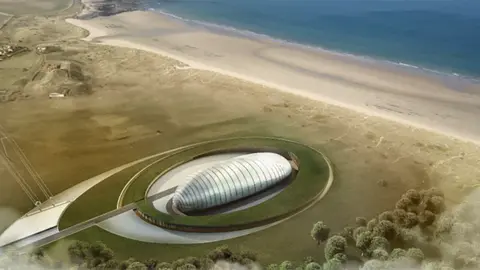Rolls-Royce plans mini nuclear reactors by 2029
 Rolls-Royce
Rolls-RoyceMini nuclear reactors could be generating power in the UK by the end of the decade.
Manufacturer Rolls-Royce has told the BBC's Today programme that it plans to install and operate factory-built power stations by 2029.
Mini nuclear stations can be mass manufactured and delivered in chunks on the back of a lorry, which makes costs more predictable.
But opponents say the UK should quit nuclear power altogether.
They say the country should concentrate on cheaper renewable energy instead.
Environmentalists are divided over nuclear power, with some maintaining it is dangerous and expensive, while others say that to achieve net zero emissions by 2050 all technologies are needed.
However, the industry is confident that mini reactors can compete on price with low-cost renewables such as offshore wind.
Rolls-Royce is leading a consortium to build small modular reactors (SMRs) and install them in former nuclear sites in Cumbria or in Wales. Ultimately, the company thinks it will build between 10 and 15 of the stations in the UK.
They are about 1.5 acres in size - sitting in a 10-acre space. That is a 16th of the size of a major power station such as Hinkley Point.
SMRs are so small that theoretically every town could have its own reactor - but using existing sites avoids the huge problem of how to secure them against terrorist attacks.
It is a rare positive note from the nuclear industry, which has struggled as the cost of renewables has plummeted.
In the past few years, major nuclear projects have been abandoned as Japanese companies Toshiba and Hitachi pulled out because they could not get the required funding.
And the construction of Hinkley Point in Somerset could cost £3bn more than was expected, in an echo of the row over the rail mega-project HS2.
"The trick is to have prefabricated parts where we use advanced digital welding methods and robotic assembly and then parts are shipped to site and bolted together," said Paul Stein, the chief technology officer at Rolls-Royce.
He said the approach would dramatically reduce the cost of building nuclear power sites, which would lead to cheaper electricity.
But Paul Dorfman from University College London said: "The potential cost benefits of assembly line module construction relative to custom-build on-site construction may prove overstated.
"Production line mistakes may lead to generic defects that propagate throughout an entire fleet of reactors and are costly to fix," he warned.
"It's far more economic to build one 1.2 GW unit than a dozen 100 MW units."
Rolls-Royce is hoping to overcome the cost barrier by selling SMRs abroad to achieve economies of scale.
Its critics have warned that SMRs will not be ready in substantial numbers until the mid 2030s, by which time electricity needs to be carbon-free in the UK already to meet climate change targets.
